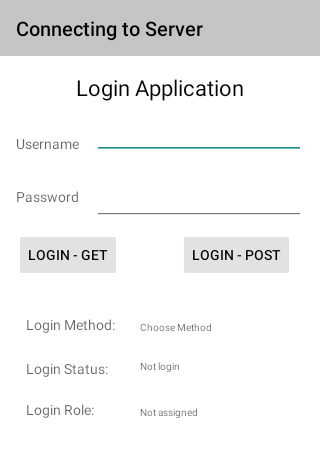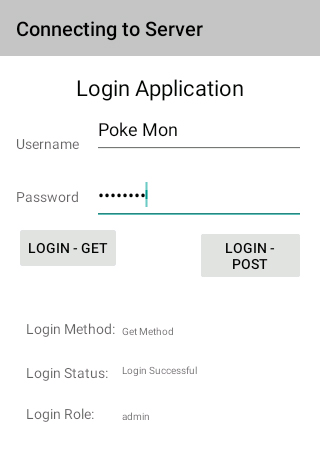package com.wenchen.server;
import android.content.Context;
import android.os.AsyncTask;
import android.widget.TextView;
import java.net.URL;
import java.net.URLConnection;
import java.net.URLEncoder;
import java.io.BufferedReader;
import java.io.InputStreamReader;
import java.io.OutputStreamWriter;
public class SigninActivity extends AsyncTask<String, Void, String> {
private TextView statusField, roleField;
private Context context;
private int byGetOrPost = 0;
// Flag 0 means GET and 1 means POST. (By default it is GET.)
public SigninActivity( Context context, TextView statusField, TextView roleField, int flag ) {
this.context = context;
this.statusField = statusField;
this.roleField = roleField;
byGetOrPost = flag;
}
protected void onPreExecute( ) { }
@Override
protected String doInBackground( String... arg0 ) {
try {
String username = (String) arg0[0];
String password = (String) arg0[1];
String link = "http://undcemcs01.und.edu/~wen.chen.hu/course/457/11/Android/";
// Complete the URL.
if ( byGetOrPost == 0 ) { // Get method
link += "LoginGet.cgi";
link += "?username=" + URLEncoder.encode( username, "UTF-8" );
link += "&password=" + URLEncoder.encode( password, "UTF-8" );
}
else { // Post method
link += "LoginPost.cgi";
}
// Connect to the server.
URL url = new URL( link );
URLConnection conn = url.openConnection( );
conn.setDoOutput( true );
// Send the arguments via standard output for the POST method.
if ( byGetOrPost == 1 ) { // Post method
String data = URLEncoder.encode( "username", "UTF-8" ) + "=";
data += URLEncoder.encode( username, "UTF-8" ) + "&";
data += URLEncoder.encode( "password", "UTF-8" ) + "=";
data += URLEncoder.encode( password, "UTF-8" );
OutputStreamWriter wr = new OutputStreamWriter(
conn.getOutputStream( ) );
wr.write( data );
wr.flush( );
}
// Read server response.
BufferedReader reader = new BufferedReader(
new InputStreamReader( conn.getInputStream( ) ));
StringBuilder sb = new StringBuilder( );
String line = null;
while (( line = reader.readLine( ) ) != null ) {
sb.append( line );
break;
}
return sb.toString( );
}
catch( Exception e ) {
return new String( "Exception: " + e.getMessage( ) );
}
}
@Override
protected void onPostExecute( String result ) {
this.statusField.setText( "Login Successful" );
this.roleField.setText ( result );
}
}
|

